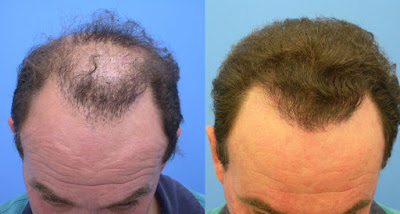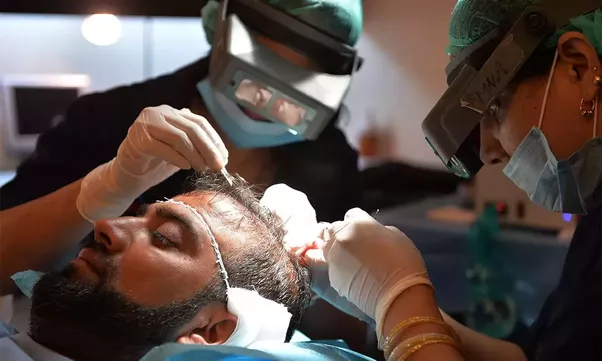Hair Transplant | Hair Loss
Hair Transplant Clinic in Mumbai
The young man who is losing his hair is a challenge to the Hair Transplant surgeon. He is often extremely distressed about his follicular future and the initial consultation must balance the patient's emotions with the reality of his hair loss. Some surgeons may deal with this situation by adhering to a minimum age policy. "I won't operate on anyone under 25." But should there really be a minimum age? With the transformation of hair transplantation into a microsurgical procedure and the availability of effective medical treatments for hair loss, we now have the opportunity to more confidently treat this age group.
Consider the young patient under 25 years old. There are advantages to working with these patients. They are highly motivated, generally healthy individuals who are rarely on medication. Many of these patients are devastated by the early loss of their hair and we have the opportunity to restore their confidence, and self-esteem as well as their hair. With early surgical intervention the surgeon can keep up with the patient's hair loss and he will never look bald. Furthermore, most of these patients still have some existing hair, which makes the surgery easier to camouflage.
There are also potential hazards when transplanting this younger age group, that need to be addressed in detail during the initial consultation. Their expectations are very high and sometimes unreasonable. They want their hairlines where it was when they were 15 and they invariably want more density than is technically possible.
Often their decision to have surgery is an impulsive one. These young men are experiencing their first encounter with the aging process and many of them are not emotionally or intellectually able to deal with it. The patient must understand that once beginning hair transplantation, it is a lifetime commitment because they may need additional surgeries to keep up with their hair loss. But the most difficult issue of all is the estimation of future hair loss. The progression of androgenetic alopecia must never be underestimated. Failure to do so can lead to a cosmetic disaster.
For a successful end result, the surgeon must be cautious and conservative in long term planning. Examination of male parents and siblings and evaluation of family photographs can be very helpful in predicting the ultimate pattern of loss. This is a challenging group, but they should not be denied access to hair transplantation, solely because of their age.
The following guidelines are recommended to achieve a successful surgical result when transplanting patients under 25 years of age.
• Place the hairline higher than where the patient wants. Follow the rule of thirds and then push the patient to accept an even higher hairline. Hairlines should not be less than 8 cm above the mid glabella line. Preferably it should be at least 9 cm. A higher hairline conserves donor's hair. Every centimeter higher saves hundreds of hairs that may be needed in later years. Also, by reducing the area to be transplanted, greater density can be achieved with the same amount of donor's hair.
• As the patient ages, a higher hairline will only look more natural. If this issue reaches an impasse after all of this has been explained, which it often does, the patient should be advised that the hairline can always be lowered during subsequent procedures. Always try to buy time. Raising the hairline is extremely difficult and it is usually cosmetically unacceptable.
• Avoid transplanting the vertex because of the difficulty in accurately estimating future Hair Loss. By starting in the frontal area, and continuing back as hair loss progresses, the patient will always have enough donor hair to adequately cover these areas in the future. If the vertex is transplanted at this early age, there is a risk of depleting the donor hair that will be needed later. Without the necessary donor hair, the patient can end up with islands of hair that are not connected or insufficient density in the frontal scalp.
• Use caution when transplanting temporal angles. In the old days, many surgeons avoided transplanting temporal angles because of unsightly results with full-size grafts or large mini grafts. Now, cosmetically acceptable results can be achieved using follicular units and maintain a slightly receded concave hairline. Because the temporal fringe naturally flattens as one age, avoid creating a permanent temporal point that is too far anterior which will look inappropriate in the future.
• Start the patient on medical therapy. Finasteride with or without minoxidil has the potential to significantly reduce future hair loss and may even promote growth particularly in the vertex. The new 5-year data on Finasteride shows that 66% of treated patients have significantly more hair in the vertex than when they started. The effectiveness of both of these drugs in the vertex is another reason to delay transplanting in this area. By preventing or reducing the potential for further hair loss, the surgeon has a much greater margin of safety.
• Look for clinical clues that may portend the development of extensive future hair loss (type VII). The presence of "whisker hair" and poor temporal density are signs that suggest an early onset of potentially significant baldness. Norwood first described whisker hair as short curly hairs that are found above the ears that have characteristics of beard hair. He suggested a correlation between significant future baldness and the presence of these hairs.
When examining the young patient the temporal density should be carefully determined. Early significant thinning in this area may also be a sign of impending follicular disaster.
• Select the safest donor areas. The mid-occipital area should be selected for the initial procedures because it is the least likely to thin over time. Subsequently, the donor area can be expanded inferiorly and superiorly as determined by the pattern of hair loss. The temporal donor sites should be saved for later years because the future density of these sites is less predictable.
Defer scheduling surgery during the first consultation. Resist the temptation. Have the patient return for a second consultation, preferably in 6 months. Although this may be a difficult business decision, I believe that this is the most appropriate medical decision for this age group. You will be able to weed out any emotionally impulsive or psychologically unstable individuals who would be unsuitable for surgery. By deferring the surgery, the surgeon will then be able to evaluate how rapidly the hair loss is progressing and how well any medical treatment might be working.
By proceeding in this manner, the groundwork for a positive long-term relationship and a successful surgical experience will be in place. With the latest advances in microsurgical techniques and the availability of effective medical therapy for hair loss, we should reconsider the concept of a minimum age and be more confident treating a younger patient population. By following these recommended guidelines, the surgeon should be able to avoid cosmetically unacceptable results in the future.
< a href="http://assureclinic.com/Hair-Transplant">Hair Transplant in Mumbai</a>
< a href="http://assureclinic.com/Hair-Transplant">Hair Transplant in Mumbai</a>




Comments
Post a Comment